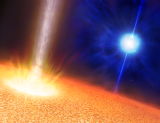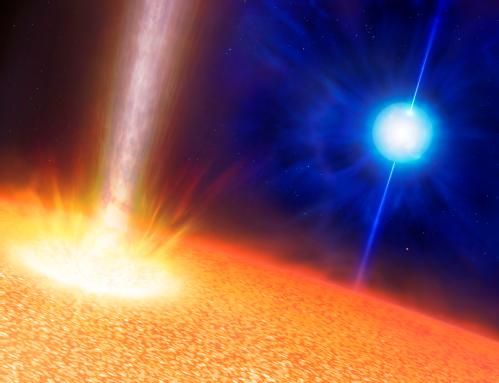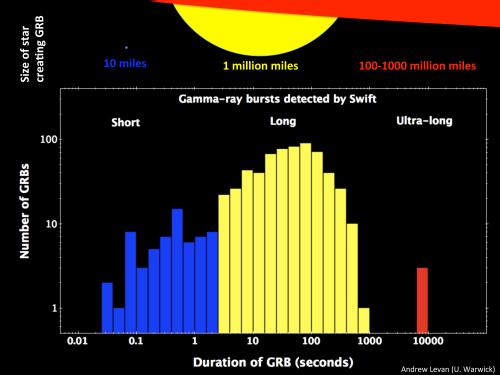Strange new bursts of gamma-rays point to a new way to destroy a star
 A team led by the University of Warwick has pinpointed a new type of exceptionally powerful and long-lived cosmic explosion, prompting a theory that they arise in the violent death throes of a supergiant star.
A team led by the University of Warwick has pinpointed a new type of exceptionally powerful and long-lived cosmic explosion, prompting a theory that they arise in the violent death throes of a supergiant star.
These explosions create powerful blasts of high energy gamma-rays, known as gamma-ray bursts, but while most bursts are over in about a minute, this new type can last for several hours.
The first example was found by astronomers on Christmas Day 2010, but it lacked a measurement of distance and so remained shrouded in mystery with two competing theories put forward for its origin.
The first model suggested it was down to an asteroid, shredded by the gravity of a dense neutron star in our own galaxy, the second that it was a supernova in a galaxy 3.5 billion light years away, or in the more common language of astronomers at a redshift of 0.33.
A new study by a team of scientists led by Dr Andrew Levan at the University of Warwick finds several more examples of these unusual cosmic explosions and shows that the Christmas Day burst took place in a galaxy much further away than the two theories suggested.
This research is to be presented at the GRB 2013 Symposium in Nashville, Tennessee on Tuesday 16 April.
Using data from the Gemini Telescope in Hawaii, the scientists calculated that this ultra-long gamma-ray burst had a redshift of 0.847. This gives it a location of approximately half-way to the edge of the observable universe, or 7 billion light years away.
Armed with its location, Dr Levan’s team, which included scientists from an international collaboration, has developed a new theory to explain how it occurred.
They suggest this kind of burst is caused by a supergiant, a star 20 times more massive than the sun, which evolves to become among the biggest and brightest stars in the universe with a radius of up to 1 billion miles - up to 1,000 times that of the sun.
They believe the ultra-long durations of the Christmas gamma-ray burst and two other similar bursts are simply down to the sheer size of the supergiants exploding in a supernova.
Most stars that create gamma-ray bursts are thought to be relatively small and dense, and the explosion that destroys them punches through the star in a matter of seconds. In the case of these new ultra-long bursts the explosion takes much longer to propagate through the star, and so the gamma-ray burst lasts for a much longer time.
Dr Levan said: “These events are amongst the biggest explosions in nature, yet we’re only just beginning to find them.
“It really shows us that the Universe is a much more violent and varied place than we’d imagined.
“Previously we’ve found lots of gamma-ray events with short durations, but in the past couple of years we’ve started to see the full picture.”
Nial Tanvir, a professor at the University of Leicester, and second author of the study added: “We believe that powering the explosion is a newly formed black hole in the heart of the star.
“Predicting the detailed behaviour of matter falling into a black hole in these circumstances turns out to be very difficult, and from a theoretical point of view we didn’t initially expect explosions at all.
“The amazing thing is that nature seems to have found ways of blowing up a wide range of stars in the most dramatic and violent way.”
The more common type of gamma-ray burst is thought to be caused when a Wolf-Rayet star in the final phase of its evolution collapses into a black hole at its own core.
Matter is drawn into the black hole, but some of its energy escapes and is focussed into a jet of material which blasts out in two directions forming copious gamma-rays in the process.
These jets are ejected extremely quickly (close to the speed of light), otherwise the material would fall into the black hole from which it can’t escape. For this reason they last only a few seconds.
However, a gamma-ray burst in a bigger star the size of a supergiant needs to power through a larger reservoir of material, hence its longer duration.
ENDS
For further details please contact:
Dr Andrew Levan
Department of Physics, University of Warwick
Mobile/cell +44 (0)7714 250373
Office +44 (0)2476 574740
a dot j dot levan at warwick dot ac dot uk
NOTE: Andrew Levan will be travelling to the conference from Saturday 13 April and should be reached via mobile or skype (andrewlevan1) after this time.
Anna Blackaby
Communications Office, University of Warwick
Mobile/cell +44 (0)7885 433155
Office +44 (0)2476 575910
a dot blackaby at warwick dot ac dot uk
Images
Image 1: An artist’s impression of the stars creating gamma-ray bursts. The background blue star is the progenitor of a standard long duration gamma-ray burst. A so -called Wolf-Rayet star, it has a mass ten or more times the mass of the sun but has a comparable size. The foreground star is the suggested progenitor of an ultra-long gamma-ray burst (GRB). It has a mass of perhaps 20 times the sun but is up to a thousand times larger. In both cases the GRB is produced by a jet punching through the star, but in the case of the ultra-long GRBs the much larger size of the star creates a much longer lived jet.
Image copyright Mark A. Garlick, used with permission by the University of Warwick
Image 2: The lower panel shows the three types of GRB, the short and long duration bursts that have been known for many years and the newly discovered population of ultra-long GRBs.
Credit: Andrew Levan, University of Warwick
For further details please contact:
Dr Andrew Levan
Department of Physics, University of Warwick
Mobile/cell +44 (0)7714 250373
Office +44 (0)2476 574740
a dot j dot levan at warwick dot ac dot uk
NOTE: Andrew Levan will be travelling to the conference from Saturday 13 April and should be reached via mobile or skype (andrewlevan1) after this time.
Anna Blackaby
Communications Office, University of Warwick
Mobile/cell +44 (0)7885 433155
Office +44 (0)2476 575910
a dot blackaby at warwick dot ac dot uk



